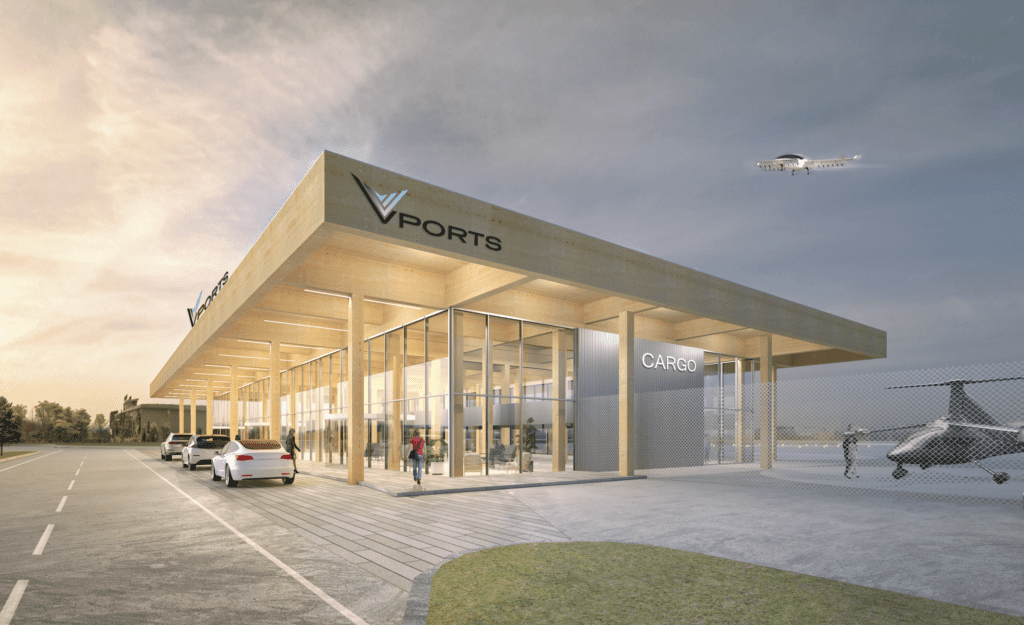
VPorts recently announced that it will create corridors for eVTOL aircraft between Quebec and the U.S. The Canadian startup also plans to establish a network of vertiports in Quebec. (Photo: VPorts)
Last month, Canadian startup VPorts shared plans to establish a network of vertiports in Quebec as well as to create corridors between Quebec and the U.S. specifically for electric vertical take-off and landing (eVTOL) aircraft. The company plans to start conducting eVTOL test flights along these corridors in 2023.
VPorts is planning to construct a vertiport network that connects all major Quebec regions by the year 2030. A longer-term objective is to build and operate 1,500 vertiports worldwide by 2045. This first vertiport network will provide take-off and landing locations for electric advanced air mobility (AAM) aircraft in addition to the necessary charging infrastructure. According to the company’s announcement, each vertiport will have both charging stations and hydrogen fuel stations to accommodate hybrid and other types of AAM vehicles.
“We work with different companies to assist us in selecting locations for vertiports,” Dr. Fethi Chebil, president and founder of VPorts, told Avionics International in an interview. “We also do socio-economic studies to understand the movement of people and goods today in order to locate our vertiports in support of these findings.”
“We consider the weather, the air traffic, and the existing air traffic management or operation around the cities,” he explained.

According to Dr. Fethi Chebil, president and founder of VPorts, the AAM industry is made up of three pillars: manufacturers of eVTOL aircraft; the necessary charging facilities; and infrastructure—vertiports and integration of air traffic management. (Photo: VPorts)
The company’s initial growth strategy for its vertiport network in Quebec is centered around the regional transportation of goods as well as transporting patients, medical equipment, and organs for transplants. The team at VPorts will collaborate with NAV CANADA, Transport Canada, the Government of Quebec, and municipal officials to determine regulations for safety and security.
Other participants in the project include NUAIR, which is developing the operational concept and requirements; UAM Geomatics, doing geospatial mapping and forecasting cost and revenue; Innovitech, developing a strategy for managing stakeholders; and AEdifica, which is developing the concept for the network’s architecture.
Quebec is an ideal region for introducing eVTOL operations and developing a network of vertiports, Dr. Chebil believes.”It is challenging to use existing ground transportation or regional air transportation,” he said. “That’s why having eVTOLs would help a lot in terms of connecting the region to the rest of Quebec.”
In addition to the vertiport network, VPorts also plans to create a Vertiport Operation Control Centre (VOCC) in Montreal to manage vertiports located around the world.

A map of the planned vertiport network (Photo: VPorts)
The electric AAM corridors that VPorts is developing—between Quebec and the state of New York—are part of a Memorandum of Understanding (MOU) signed by Aéro Montréal, the Unmanned Aerial System Centre of Excellence (Alma), NUAIR, Innovitech, and Helijet International. Other states besides New York have expressed interest in the creation of a corridor for eVTOLs to travel to and from Canada, according to Dr. Chebil.
He has observed during his tenure as an Airport Safety Expert for the International Civil Aviation Organization (ICAO) that regulators are moving quickly to enable AAM. “One of the key challenges right now is understanding how regulators will adapt to this industry,” he said.
One of the most important of VPorts’ current projects is expansion in Europe, which will be announced soon, Dr. Chebil shared. Switzerland is where the company is most likely to launch services, he said, because of the country’s geographic position and programs supporting AAM technology.
“We are also working on ongoing projects in the Middle East, India, and Africa,” he added. These projects require significant time and effort, with many people onsite working to develop an understanding of how to coordinate with the governments in these regions. “In many cities, AAM is completely new. It’s a lot of effort to explain advanced air mobility—eVTOL aircraft, vertiports, where the challenges are, etc.,” he explained.